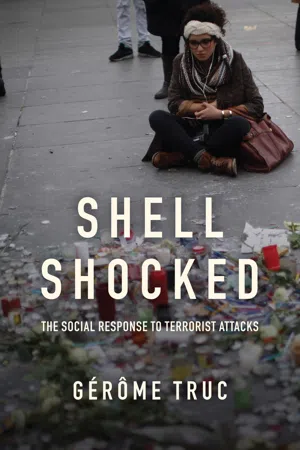Even if some terrorist attacks come as less of a surprise than others, every attack, at the time it is carried out, creates a new and uncertain situation that needs to be defined. What is happening? What do I now need to expect? What should be done? Answering these questions requires what the American sociologist Erving Goffman calls a ‘framework’,4 i.e. ‘a cognitive and practical structure for organizing social experience, enabling us to understand what is happening to us and to take part in it’.5 A framework is not just an interpretation, a representation or an after-the-event narrativization of what has happened. It becomes apparent in the very course of ongoing events, by way of describable activities – the framing operations – that help us to explain the events, specify which people are concerned by them, and decide on the best way to react to them. As one case of uncertainty as to the framework of a particular situation, Erving Goffman takes the example of the blackout that, on 30 November 1965, plunged the north-eastern United States into darkness: ‘With the lights failing all over New York, the individual does not know whether there has been a technical failure, an enemy attack, or sabotage.’6 It was exactly this same uncertainty that marked the first hours of 11 September 2001. When, a few seconds after 8.46 a.m., New Yorkers suddenly heard the noise of a loud explosion coming from the south of Manhattan,7 and turned to look at the towers of the World Trade Center, they realized that the north tower was on fire. But the vast majority of them did not at that time know what had led to the blaze.
11 September 2001, 8.46 a.m.: The need to define a situation
The event instantly reached American newsrooms, which thereupon kept their cameras permanently trained on Manhattan. CNN was the first national channel to interrupt its programme, a few seconds before 8.50 a.m., to broadcast a static shot showing a thick cloud of smoke rising from the upper floors of the north tower of the World Trade Center into the clear blue sky of that Tuesday morning.8 Superimposed on the image were the words ‘World Trade Center Disaster’. At this stage, CNN journalists had no reliable information at their disposal. They spoke of ‘something devastating’ and mentioned the possibility of a plane crashing into the tower only as a hypothesis, stemming from ‘unconfirmed reports’.
At the same time, CNN reporters were roaming the streets of Manhattan looking for eyewitnesses. The first hours of live media coverage of 9/11, on both television and radio, in the United States as in the rest of the world, would give a great deal of space to these eyewitness accounts gathered in the streets.9 But these were partial and often contradictory: some people swore that the tower had imploded from within and confirmed that they had heard reports of a bomb, while others stated that they had seen a plane flying in over Manhattan at a very low altitude just before the explosion in the tower. But at that time, nobody had access to any image that would enable this to be confirmed with certainty.10 So there was a plethora of hypotheses as to what kind of plane had been involved: a small tourist plane such as a Cesna, or an airliner, maybe a Boeing? In the former case, it might be an accident, but in the latter, it might have been a hijacked plane. Furthermore, the weather conditions, which on that morning were perfect, did not make an accidental crash seem likely.
Suddenly, at 9.03 a.m., just as one witness was on air stating that he had seen a big plane embedding itself in the north tower of the World Trade Center, a plane in flight surreptitiously appeared on the image for a fraction of a second, then vanished. The picture was interrupted for a moment, then the screen showed a ball of fire. The static shot broadcast by CNN did not distinguish between the Twin Towers, and so it was some time before the journalists gathered what had just happened: initially, they thought there had been a second explosion in the same tower. Then, when they realized that it was in fact the south tower that was now on fire, they again mentioned the possibility of a plane crash, but only as a hypothesis that needed to be verified. The framework of the developing situation was still very ill-defined.
However, this framework would become clear over the next half hour, as experts (especially those from air security and the FBI) were contacted by journalists, and press releases were issued by Associated Press and Reuters. The hypothesis of a hijacked plane gained ground, while an accident started to seem increasingly unlikely. Journalists were now talking in terms of a probable ‘terrorist act’. At 9.29 a.m., President Bush, speaking from Emma Booker Elementary School in Sarasota, Florida, where he was visiting, made a brief statement in which he spoke of a ‘national tragedy’ and an ‘apparent terrorist attack on our country’. Barely eight minutes later, at 9.37 a.m., journalists reported a new explosion, this time at the Pentagon, Washington. Less than one hour after the first plane had crashed, there was no further room for doubt: these were not accidents, and the United States was the target for several coordinated attacks.
The event now became international in its scope. In Europe, it was the mi...
